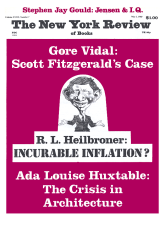In response to:
Della Robbia Disputes from the April 17, 1980 issue
To the Editors:
I am surprised and a little puzzled by Professor Janson’s review of my Luca della Robbia in your last issue [NYR, April 17]. I have never believed that “le style c’est l’homme,” and I have never indeed met any art-historian who did so. Had I entertained this foolish view, I would not have gone to considerable pains to reconstruct that part of Luca’s life which is exactly reconstructible, and to define, as closely as the evidence allows, the historical and social background from which his great commissions spring. For better or worse Janson and I are two different kinds of art-historians. My concern is with the analysis of surviving works of art, his is with ideas encapsulated in a dialectical cocoon. Lack of evidence cannot be redressed by argument. When I wrote that “hypothetically Luca might have gravitated to the shop” of Michelozzo, I chose the tense deliberately because, after a very careful re-examination of the surviving monuments, I found no piece of figure sculpture in them, no detail and no ornament, that could with the remotest possibility be ascribed to Luca della Robbia. A couple of wings and a pair of Roman military boots are not proof of association, far less of identity of authorship. I left the matter of Luca’s formation in the 1420s open for no better reason than that that it is what the evidence forces one to do.
As for Alberti’s encomium of Luca della Robbia—Janson’s hero Michelozzo is not, of course, mentioned by Alberti—I concluded that it must relate not to past accomplishment but, as the phrase translated “genius for every laudable enterprise” would seem to indicate, to the work on which Luca was currently engaged. I argue in my book that the Cantoria was master-minded by Brunelleschi, was probably planned with the assistance of Niccoli and other humanists (“le style c’est les hommes” I suppose Janson would call it), and illustrates a number of principles outlined in Alberti’s Della Pittura. The attitude to the antique that if embodies was thus different (not better or worse, not more or less original, just different) from that of Michelozzo and Donatello, and was developed in a number of Brunelleschi-inspired commissions in enamelled terracotta, notably the Resurrection in the Cathedral. When I described this as “the first significant Renaissance reinterpretation of the traditional Resurrection iconography,” I meant precisely what I said. Whether the central figure on Michelozzo’s Aragazzi Monument represents God the Father, or St. Bartholomew, or Christ as Janson claims, it does not show Christ rising from the tomb with sleeping soldiers around it, and is therefore in this context totally irrelevant. Should Janson seriously believe that a marble relief in its position would have been as legible as a white enamelled terracotta, I can only suggest that he return to the Cathedral, stand half-way up the nave, and for once use his eyes. It is hard luck on Luca della Robbia that he (like Fra Angelico) should have been idolized in the nineteenth century, but this affords no license for truck-driver Janson to run him down. The maxim “le style c’est l’homme même” may be inapplicable to Renaissance sculptors, but it has a lethal relevance to this review.
John Pope-Hennessy
New York City
This Issue
May 1, 1980



